The Caribbean Island Of Cuba
|

The Republic of Cuba is an island country in the Caribbean. It
consists of the island of Cuba, the Isla de la Juventud, and several archipelagos.
Havana is the largest city in Cuba and the country's capital. Santiago de Cuba is the second
largest city. Cuba is home to over 11 million people and is the most populous insular nation in the
Caribbean. Its people, culture, and customs draw from diverse sources, including the aboriginal
Taíno and Ciboney peoples; the period of Spanish colonialism; the introduction of African slaves;
and its proximity to the United States.
Provinces and
municipalities
The provinces are divided into various municipalities.
Fourteen provinces and one special municipality (the Isla de la Juventud) compose Cuba. These were
formerly part of six larger historical provinces: Pinar del Río, Habana, Matanzas, Las Villas,
Camagüey and Oriente. The present subdivisions closely resemble those of Spanish military provinces
during the Cuban Wars of Independence, when the most troublesome areas were subdivided.
1 Isla de la Juventud (Isle of Youth)
2 Pinar del Río
3 La Habana (Havana)
4 Ciudad de la Habana (Havana City)
5 Matanzas
6 Cienfuegos
7 Villa Clara
|
8 Sancti Spíritus
9 Ciego de Ávila
10Camagüey
11Las Tunas
12 Granma
13 Holguín
14 Santiago de Cuba
15Guantánamo
|
|
Cuba's History
|
|
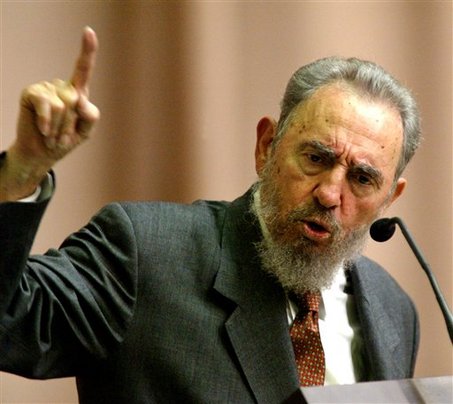
Prior to the arrival of the Spanish, the island was inhabited by Native American
peoples known as the Taíno and Ciboney whose ancestors had come from South and possibly North and
Central America at least several and perhaps 60 to 80 centuries before.not in citation given] The
Taíno were farmers and the Ciboney were farmers and hunter-gatherers; some have suggested that
copper trade was significant and mainland artifacts have been found.
On October 12, 1492, Christopher Columbus landed near what is now Baracoa and
claimed the island for Spain, and naming it Isla Juana after Prince Juan of Asturias. In 1511 the
first Spanish settlement was founded by Diego Velázquez de Cuéllar at Baracoa; other towns
including the future capital of the island San Cristobal de la Habana (founded in 1515) soon
followed.
The Spanish enslaved the approximately 100,000 indigenous people who resisted
conversion to Christianity, setting them primarily to the task of searching for gold, and within a
century they had all but disappeared. Most scholars now believe that infectious disease was the
overwhelming cause of the population decline of the indigenous people.
|
|
Colonial Cuba
Cuba remained
a Spanish possession for almost 400 years (1511-1898). Its economy was based on plantation
agriculture, mining and the export of sugar, coffee and tobacco to Europe and later to North
America. The small land-owning elite of Spanish-descended settlers held social and economic power,
supported by a population of Spaniards born on the island (Criollos), other Europeans, and
African-descended slaves.
In the 1820s, when the other parts of Spain's empire in Latin America rebelled and
formed independent states, Cuba remained loyal, although there was some agitation for independence,
leading the Spanish Crown to give it the motto "La Siempre Fidelísima Isla" (The Always Most
Faithful Island). This loyalty was due partly to Cuban settlers' dependence on Spain for trade,
protection from pirates, protection against a slave rebellion and partly because they feared the
rising power of the United States more than they disliked Spanish rule.
Cuban independence from
Spain was the motive for a rebellion in 1868 led by Carlos Manuel de Céspedes. This resulted in a
prolonged conflict known as the Ten Years' War. The US declined to recognize the legitimacy of the
Cuban government in arms, even though many European and Latin American nations had done so. In 1878
the Pact of Zanjón ended the conflict, with Spain promising greater autonomy to Cuba. In 1879-1880,
Cuban patriot Calixto Garcia attempted to start another war, known as the Little War, but received
little support.
Slavery was abolished in
1886, although the African-descended minority remained socially and economically oppressed. During
this period rural poverty in Spain provoked by the Spanish Revolution of 1868 and its aftermath led
to even greater Spanish emigration to Cuba. During the 1890s pro-independence agitation revived,
fueled by resentment of the restrictions imposed on Cuban trade by Spain and hostility to Spain's
increasingly oppressive and incompetent administration of Cuba. Few of Spain's promises for
economic reform in the Pact of Zanjón were kept.
In April 1895 a new war was declared, led by the writer and poet José Martí, who
had organized the war over 10 years, and proclaimed Cuba an independent republic - Martí was killed
at Dos Rios shortly after landing in Cuba with the eastern expeditionary force. His death
immortalized him and he has become Cuba's national hero. The 200,000 Spanish troops outnumbered a
much smaller rebel army which relied mostly on guerrilla and sabotage tactics.
The Spaniards began a campaign of suppression. General Valeriano Weyler, military
governor of Cuba, herded the rural population into what he called reconcentrados, described by
international observers as "fortified towns". These are often considered the prototype for 20th
century concentration camps. Between 200,000 and 400,000 Cuban civilians died from starvation and
disease during this period in the camps. These numbers were verified by the Red Cross and US
Senator (and former Secretary of War) Redfield Proctor. US and European protests against Spanish
conduct on the island followed.
|
Cuba's
Independence
Top
|
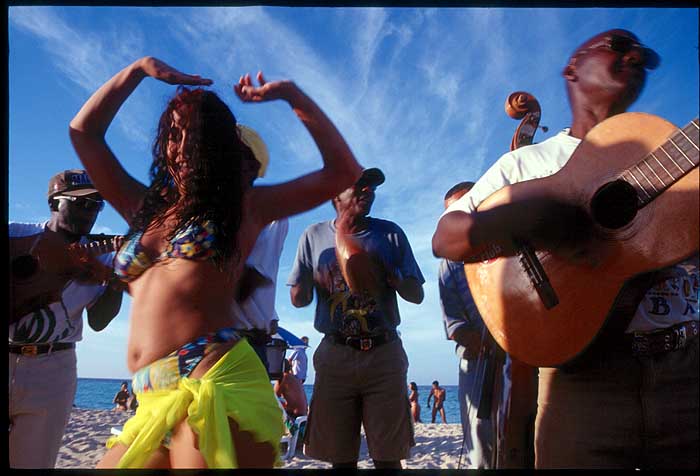 As an outcome of the
Spanish-American War, Spain ceded Cuba, along with Puerto Rico, the Philippines, and Guam to
the US under the 1898 Treaty of Paris. As an outcome of the
Spanish-American War, Spain ceded Cuba, along with Puerto Rico, the Philippines, and Guam to
the US under the 1898 Treaty of Paris.
Theodore Roosevelt, who had fought in the Spanish-American War
and had some sympathies with the independence movement, succeeded McKinley as President of the
United States in 1901 and abandoned the 20-year treaty proposal. Instead, the Republic of Cuba
gained formal independence from the United States of America on May 20, 1902. Under the new Cuban
constitution, however, the US retained the right to intervene in Cuban affairs and to supervise its
finances and foreign relations. Under the Platt Amendment, Cuba also agreed to lease to the US the
naval base at Guantánamo Bay.
In 1906, following disputed elections, an armed revolt led by Independence War
Veterans defeated the meager government forces loyal to its first president, Tomás Estrada Palma
and the US intervened. The country was placed under US occupation and a US governor, Charles Edward
Magoon, took charge for three years. Magoon's governorship in Cuba was viewed in a negative light
by many Cuban historians for years thereafter, believing that much political corruption was
introduced during Magoon's years as governor. In 1908 self-government was restored when José Miguel
Gómez was elected President, but the US continued its intervention of Cuban affairs.
In 1912 Partido Independiente de Color attempted to establish a separate black
republic in Oriente Province. Perhaps because the group lacked sufficient weaponry, the main tactic
was to set businesses and private residences on fire. The movement was a failure and General
Monteagudo suppressed the rebels with considerable bloodshed.
|
Cuba's Geography
|
|
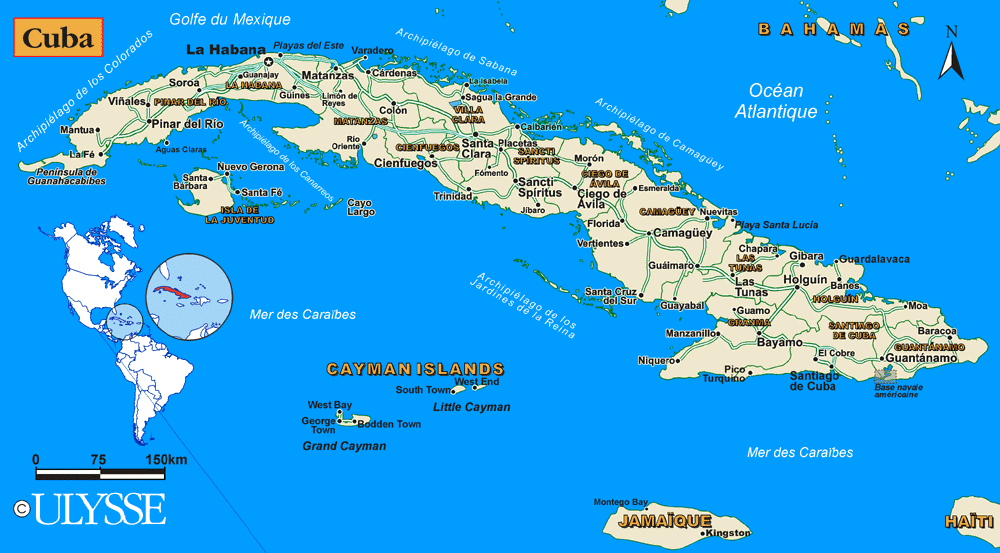
Cuba is located in the
northern Caribbean at the confluence of the Caribbean Sea, the Gulf of Mexico
and the Atlantic Ocean. Cuba is south of the eastern United States and The Bahamas, west of
the Turks and Caicos Islands and Haiti, east of Mexico and north of the Cayman Islands and
Jamaica.
Cuba is an archipelago of islands located in the Caribbean Sea, with the geographic
coordinates 21°3N, 80°00W. Cuba is the principal island, which is surrounded by four main groups of
islands. These are the Colorados, the Sabana-Camagüey, the Jardines de la Reina and the Canarreos.
The main island of Cuba constitutes most of the nation's land area or 105,006 km2 (40,543 sq mi)
and is, at 766 miles (1,233 km) long, the seventeenth-largest island in the world by land area. The
second largest island in Cuba is the Isla de la Juventud (Isle of Youth) in the southwest, with an
area of 3,056 km2 (1,180 sq mi). Cuba has a total land area of 110,860 km2 (42,803 sq
mi).
|
Cuba's Culture
|
|
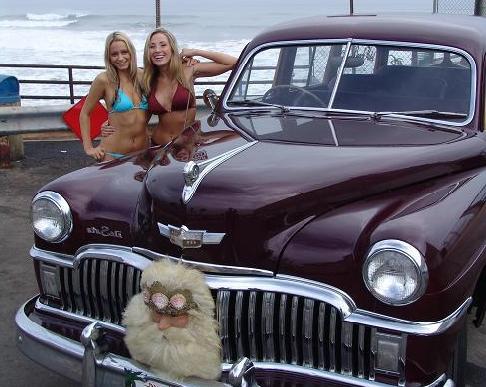
Sport is Cuba's national passion. Due to historical associations with the United
States, many Cubans participate in sports which share popularity in North America, rather than
sports traditionally promoted in other Latin American nations. Baseball is by far the most popular;
other sports and pastimes in Cuba include basketball, volleyball, cricket, and athletics. Cuba is
the dominant force in amateur boxing, consistently achieving high gold medal tallies in major
international competitions. The government of Cuba however, will not be sending competitors to the
"World Boxing Championships, based in the US city of Chicago from October 21 to November 3; this to
avoid the "theft" of athletes.
The Cuban government official newspaper alleges: "As our people are all too well
aware, the theft of anyone who stands out in Cuban society, whether s/he is an athlete,
educationalist, doctor, artist, or any kind of scientist, has been the practice of various US
governments within that country's constant policy of aggression against our people. That felony was
instigated at the very triumph of the Revolution in 1959 with the exit of thousands of doctors and
engineers.
Cuban music is very rich and is the most commonly known expression of culture.
The "central form" of this music is Son, which has been the basis of many other musical styles like
salsa, rumba and mambo and an upbeat derivation of the rumba, the cha-cha-cha. Rumba music
originated in early Afro-Cuban culture. The Tres was also invented in Cuba, but other traditional
Cuban instruments are of African and/or Taíno origin such as the maracas, güiro, marímba and
various wooden drums including the mayohuacan. Popular Cuban music of all styles has been enjoyed
and praised widely across the world. Cuban classical music, which includes music with strong
African and European influences, and features symphonic works as well as music for soloists, has
also received international acclaim thanks to composers like Ernesto Lecuona.
Havana, the Cuban capitol, was the heart of the rap scene in Cuba when it began in
the 1990s. During that time, reggaetón was also growing in popularity. The formation of Cubanitos
in 2002 by ex-members of pioneering “underground” rap group Primera Base was a pivotal moment in
the emergence of reggaetón in the capital and a watershed in Cuban rap. In the wake of this
successful bid for a higher commercial profile, most rappers have followed one of two paths:
dancing with the enemy and embracing reggaetón, or resisting the new genre vociferously. The
resisters deride reggaetón for being trite and mindless, for promoting pointless diversion and
dancing over social commitment and reflection with its lack of meaningful lyrics. Rap, on the other
hand, was seen as a way to lyrically express their opinions about things such as racism, sexism,
peace, the environment, sexuality, poverty and social inequalities. Despite this controversy,
reggaetón has become the dominant form of popular music among Cuban youth. The relationship between
Cuban rap and reggaetón continues to be debated today
Economy
The Cuban state adheres to socialist principles in organizing its largely state-controlled planned
economy. Most of the means of production are owned and run by the government and most of the labor
force is employed by the state. Recent years have seen a trend towards more private sector
employment. By the year 2006, public sector employment was 78% and private sector 22%, compared to
91.8% to 8.2% in 1981.Capital investment is restricted and requires approval by the government. The
Cuban government sets most prices and rations goods. Moreover, any firm wishing to hire a Cuban
must pay the Cuban government, which in turn will pay the company's employee in Cuban pesos
according to Human Rights Watch. Cubans can not change jobs without government permission. The
average wage at the end of 2005 was 334 regular pesos per month ($16.70 per month) and the average
pension was $9 per month.
Cuba relied heavily on trade with the Soviet Union. From the late 1980s, Soviet
subsidies for Cuba started to dry up. Before the collapse of the Soviet Union, Cuba depended on
Moscow for sheltered markets for its exports and substantial aid. The removal of these subsidies
sent the Cuban economy into a rapid depression known in Cuba as the Special Period. In 1992 the
United States tightened the trade embargo, hoping to see democratization of the sort that took
place in Eastern Europe.
Like some other Communist and post-Communist states following the collapse of the
Soviet Union, Cuba took limited free market-oriented measures to alleviate severe shortages of
food, consumer goods, and services. These steps included allowing some self-employment in certain
retail and light manufacturing sectors, the legalization of the use of the US dollar in business,
and the encouragement of tourism. Cuba has developed a unique urban farm system (the organopónicos)
to compensate for the end of food imports from the Soviet Union. In recent years, Cuba has rolled
back some of the market oriented measures undertaken in the 1990s. In 2004 Cuban officials publicly
backed the Euro as a "global counter-balance to the US dollar", and eliminated the US currency from
circulation in its stores and businesses
|
Flag of Cuba and Coat of Arm
|
|
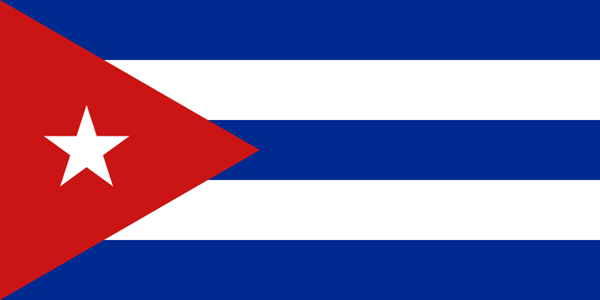
The flag of Cuba was adopted on May 20, 1902, containing a field with five blue and
white stripes, and a red equilateral triangle at the hoist with a white 5-pointed star. The flag of
Cuba was designed in 1848 for the liberation movement, which sought independence from Spain. The
flag was briefly hoisted in 1850 at Cardenas but was not officially adopted until 1902, when
independence was granted by the United States.
|
|
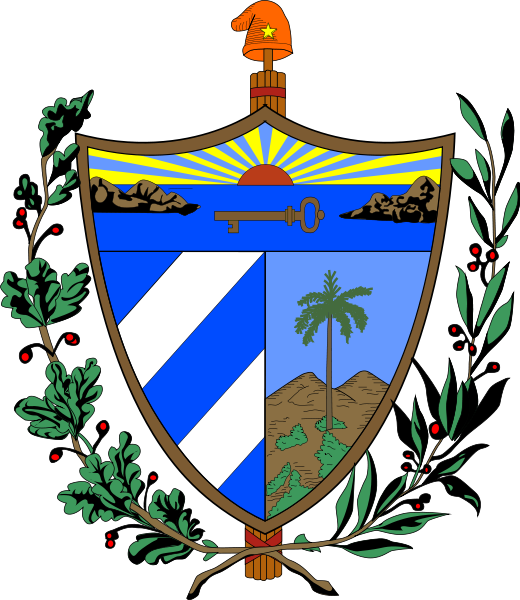
Coat of arms of Cuba
The Cuban Coat of Arms is the official heraldic symbol of Cuba. It consists of a shield, in
front of a Fasces crowned by the Phrygian Cap, all supported by an oak branch on one side and a
laurel wreath on the other. The coat of arms was created by Miguel Teurbe Tolón and was adopted on
April 24, 1906.
|
Cuba Marriage Requirements
|
|
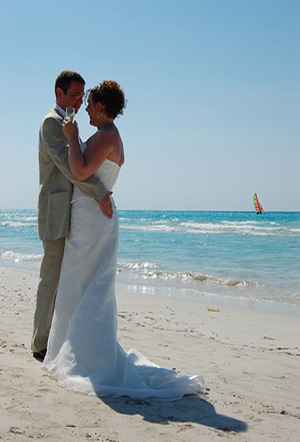
The information below outlines the marriage requirements for getting married in
Cuba
* If you have never been married before, all you need is a passport that is valid throughout your
stay in Cuba, and a tourist card (available from a travel agent, airline or the Cuban
consulate).
* If either the bride or groom has been married before, the previously married person must, in
addition to the valid passport and tourist card, also produce the following documents:
o if divorced: his/her birth certificate and Certificate of Divorce;
o if widowed: his/her birth certificate, Certificate of Marriage and Certificate of Spouse's
Death.
* Have your birth certificate and any divorce/marriage/death documents translated into Spanish and
legalized by the Cuban consul in Canada (service fee applies).
* In addition, you must:
o Create a sheet that lists your names, home address, occupations, level of education, nationality
and the full names of your parents, living or deceased.
o Attach the photo page of your passport to this sheet.
o Fax copies of all documentation (including the extras described above if you have been married
before) in both English and Spanish to your hotel in Cuba at least three weeks before your arrival
there.
o Bring all your original documents with you.
Your marriage will be formalized in the name stated on your passport. Your passport
must therefore be correct, and the name on your passport must match that on all your other
documents.
After your wedding, your Marriage Certificate will be prepared as quickly as
possible and either given to you before you leave (time permitting) or couriered at the hotel's
expense to the home address on your documents. Your marriage is legalized by the Canadian Embassy
in Havana and the Cuban Foreign Affairs department.
Registrars Offices
The registrar's office should be contacted for specific rules regarding planning
your destination or beach wedding in Cuba. They will also provide information regarding marriage
licenses and marriage certificates.
{Credit} http://www.islandbrides.com
|
|